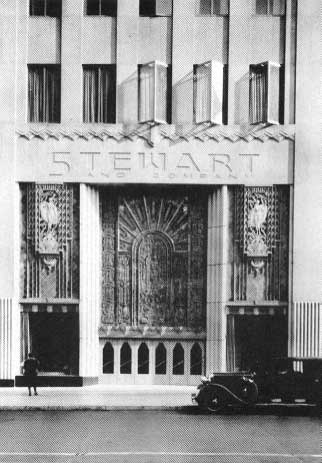The culture and art of the east was illuminated to the western world when trade routes were opened up in the 1800s. Westerners loved eastern art and a flood of eastern inspired designs washed over cities such as London. The Peacock Room in London is an example of eastern inspired design in a western context. The man the room was designed worked in the Shipping industry and was obviously involved in trade, so it was only appropriate that his decor reflect his work (Massey).
New sources of materials and technologies rotated the direction of architecture completely. The 19th century saw the introduction of glass and metal into structures starting with the Crystal Palace. An expo showing the newest technologies of machines from around the world were shown off in the new machine-like technology of the glass and metal structure of the Crystal Palace (Roth).
 Stained glass from Tassel House.
Stained glass from Tassel House. Floorplan of the main stairway in Tassel House showing the iron work and curvilinear details
Floorplan of the main stairway in Tassel House showing the iron work and curvilinear detailsMetalwork soon went from representing the straight geometric angles of machines to the curving organic qualities of the art nouveau movement. Movement and fluidity were beautifully captured in the metal work of such designs as the Tassel House designed by Victor Horta. One could say that art nouvaeu used the same sources of materials such as metal and glass and revised the male-like machine form of design into a colorful feminine form. Irony can be seen in art nouveau in that organic and human forms were recreated with industrial materials. (Massey)
While new design movements such as the arts and crafts and art nouvaeu were taking over the design world, buildings of the nineteenth century were still reflecting back on the past. The Stewart Building in New York, now demolished, is an example of a 19th century building with elements of the renaissance pasted on the front facade. The building employed art neavou elements along with the renaissance designs. The building is an early skyscraper/office building. If the building wasn't so hard to find information on I would have done my precedent analysis on it. In the library on campus there are a few very large books with plans of such buildings as The Stewart Building and that is where I first discovered it.
This week we've seen that architects were not fully branching out from the past and were still able to reflect upon ideas of the renaissance while they developed their work in art nouveu and the aesthetic movement. New trade routes and the very beginning of new technologies showed the beginnings of a new direction for architecture which would be later fulfilled in the 20th century.

No comments:
Post a Comment